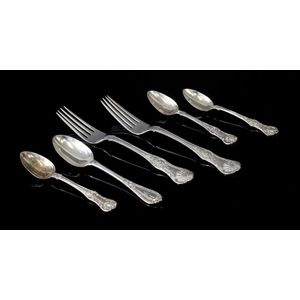Victorian Sterling Silver Tableware Set
You must be a subscriber, and be logged in to view price and dealer details.
Subscribe Now to view actual auction price for this item
When you subscribe, you have the option of setting the currency in which to display prices to $Au, $US, $NZ or Stg.
- Sterling Silver - Sterling silver is a mixture of 92.5% pure silver and 7.5% of another metal, usually copper. Fine silver is 99.9% pure silver, and is relatively soft and the addition of the very small amount of copper gives the metal enough strength and hardness to be worked into jewellery, decorative and household objects.
- Marrow Spoon - A spoon with a long handle and a narrow scoop shaped bowl, used to scoop and eat marrow from the hollow centre of roasted bones. Some marrow scoops are double ended with a different shaped bowl at each end.
- Victorian Period - The Victorian period of furniture and decorative arts design covers the reign of Queen Victoria from 1837 to 1901. There was not one dominant style of furniture in the Victorian period. Designers used and modified many historical styles such as Gothic, Tudor, Elizabethan, English Rococo, Neoclassical and others, although use of some styles, such as English Rococo and Gothic tended to dominate the furniture manufacture of the period.
The Victorian period was preceded by the Regency and William IV periods, and followed by the Edwardian period, named for Edward VII (1841 ? 1910) who was King of the United Kingdom and the British Dominions and Emperor of India for the brief period from 1901 until his death in 1910. - Hallmarks - A mark stamped on articles of precious metals in Britain, since the 14th century, certifying their purity. It derives its name from the Guild Hall of the Goldsmiths' Company, who recieved its Charter in 1327 giving it the power to assay (test the purity) and mark articles of gold and silver.
The hallmark will consist of several marks, including the:
- silver standard mark, indicating the purity of the metal. Sterling silver is .925 pure silver.
- the city mark indicating the city in which it was assayed eg London, Birmingham, York etc.
- the date mark, usually a letter of the alphabet in a particular font and case,
- a duty mark, indicating whether duty had been paid to the crown, and only in use from 1784 to 1890
The piece may include an additional mark, the maker's mark, although not forming part of the hallmark, will be located in the vicinity of the hallmarks.
Sometimes silver plated items will bear faux hallmarks, often confusing those not familiar with silver markings.
Visually similar items

Eight various hallmarked sterling silver tableware items, including 2 various butter knives, London 1845; and 1817; dinner fork, London 1825; 2 various dessert spoons, London 1830 & Sheffield 1927; and jam spoon; dessert spoon & fork. Wt. 313g 9total)

Six various George III hallmarked sterling silver soup spoons, including pair London 1797, makers George Smith IV; London 1819, maker Robert Eley; London 1806, makers Peter & William Batemen; London 1798, makers George Smith IV; and London c.1780 (marks ru

i) A part set of 5 Terry Walsh West Australian Wildflower spoons, each handle having a different wild flower design. Signed 'Stg Sil' and 'Tw' monogram. Length 12 cm, ii) A pair J. A. Linton sterling silver Arts & Crafts mustard spoons decorated with kanga

Two various sets hallmarked sterling silver coffee spoons, including 6 matching Birmingham 1910, makers Cw; and 3 matching, marked sterling. Wt. 74g (total)
